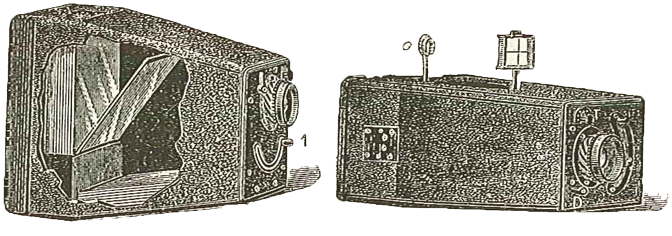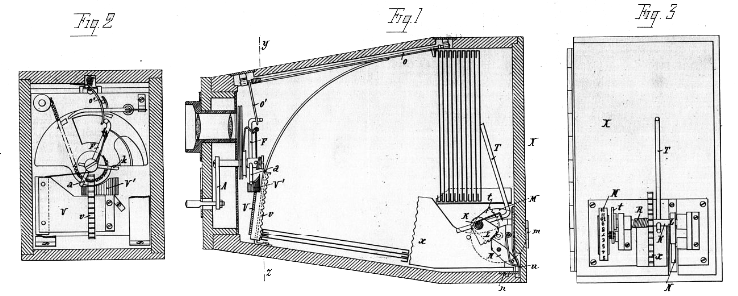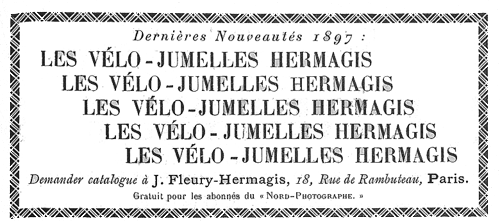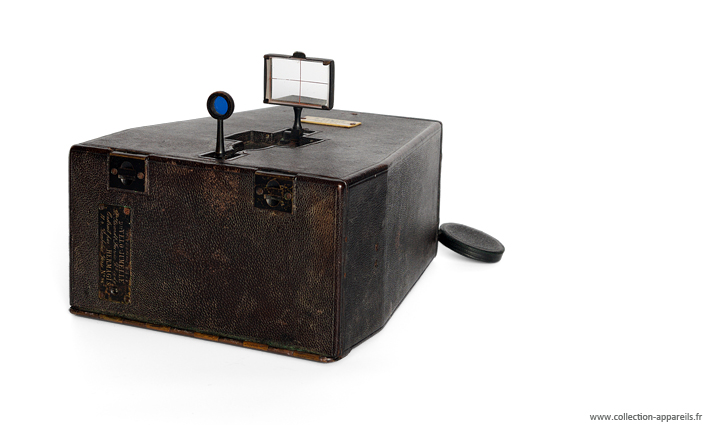|
Hermagis Vélo-Jumelle |
Manufactured or assembled in France from 1897 to (After) 1914.
Index of rarity in France: Rare (among non-specialized garage sales)
Inventory number: 3145
See the complete technical specifications
Chronology of cameras Hermagis
Fleury Jules, also known as Fleury Hermagis, was born on August 23, 1835, in Lury-sur-Arnon (Cher), France. Son of Hyacinthe Hermagis, in 1864 he took over his father's business, founded in 1845: Optique de précision et fournitures générales pour la photographie (Precision Optics and General Supplies for Photography), located at 18 Rue Rambuteau, Paris.
From 1875 to 1900, he served as honorary president of the Photographic Trade Union. In 1900, he was awarded the title of Knight of the Legion of Honor.
He authored L'Atelier de l'amateur and co-authored Traité des excursions photographiques with A. Rossignol.
The Vélo-Jumelles
The presentation of the "Vélo-Jumelle" by Hermagis in the Photo-Revue of 1897 allows us to discover this original camera:
The appearance of this new model of camera resembles that of a jumelle type camera with the minimum volume for the same format; its weight, including that of 18 plates, is only 1400 grams; it can be further reduced by using films or by optionally eliminating any number of plates, a valuable advantage rarely achieved by other systems, since most require a full magazine load to operate.
As in the universally appreciated "Vélocigraphe" 9 x 12 camera today by all connoisseurs, it is by means of an anchor escapement that plates placed vertically behind one another fall horizontally to the bottom of the chamber after each exposure (fig. 3). The principle is therefore the same, and the advantages of the system demonstrated by long practice, by numerous testimonies, are not only preserved but increased.
We will limit ourselves to summarizing them as follows:
1. Perfect and constant sealing, achieved without drawers or slides susceptible to play, jamming, or warping.
2. Smooth operation, free of misfires, and rapid with a single operating key that simultaneously produces retraction, rearming, rotation of the counter, and alignment of the fallen plates.
3. Rapid repetition (2 plates per second) essential for interesting scenes that often occur at very close intervals (groupings, attitudes, expressions, as fleeting as unexpected).
4. Inability to expose the same plate twice, as the shutter cannot operate if the plate has not been changed.
5. Precise and instantaneous focusing for all distances from 2m to infinity, using the helical mount of the lens; the focusing scale is marked on the sunshade, which is the only part projecting.
6. Equally precise and rapid framing (for both directions) using the new "iconometer" viewfinder, a type of Davanne viewfinder with reticulated divergent lens and blue glass, allowing one to determine the exact value that the finished print will have. The viewfinder fits within the thickness of the camera when not in use.
7. Optional and instantaneous exposure at 5 speeds ranging from 1/20 to 1/200 of a second using an eclipse shutter and a double-action trigger eliminating the need for a lens cap.
8. Quick unloading of exposed plates without touching those that are not exposed.
The "Vélo-Jumelle" 6.5 x 9, in mahogany covered with Morocco leather, with 18 frames, a single fast wide-angle lens, leather case with strap to hold everything, costs 180 francs.

The Vélo-Jumelle is an evolution of the Vélocigraphe, as indicated by the plate on the back of the Vélocigraphe 6 1/2 x 9 camera, also known as Vélo-Jumelle.
In the catalogs of 1898 and 1901, it is presented as the "new model Vélocigraphe," while the original Vélocigraphe continues to remain in the catalog for many years. The introduction of the Vélo-Jumelle also responds to the demand for cameras known as "twin-lens" types, which were very popular at the end of the 19th century and the beginning of the 20th century, allowing for a more modern and compact appearance.
The mechanism is the same as that of the Vélocigraphe, a system developed and patented by Dr. Ricard and Mr. Lacroix, which allows for the shutter to be armed and the plate to be changed in a single motion, while preventing double exposures. To arm the camera, one simply needs to operate the slider located on the front face, in the curved groove, and trigger it using the small lever located on the right under the lens. From there, the plate change is automatic, and thanks to an anchor escapement, the plates fall to the bottom of the chamber.
The 1901 Fleury-Hermagis catalog highlights the ability to capture two images per second and to replace plates with films.

The Vélo-Jumelle is made of mahogany covered with Morocco leather.
The available lenses are either an extra-fast Aplanastigmat Hermagis f/6.8 or a fast half-wide-angle Aplanatic Hermagis f/6.8, later replaced by a Neo-Stigmat Hermagis f/6.8.
The lens has variable focus, and adjusting the aperture requires unscrewing it.
The Davanne-type viewfinder allows precise horizontal and vertical aiming, with the rear eyepiece tinted blue.
| (non exhaustiv) | Nb plates | Hermagis lens | Shutter | Misc | |
| 6,5 x 9 | 18 | Aplanastigmat N°9 |
from 1/15 to 1/250 | Time exposure on shutter release Order of speeds 1, 2, 3, 4, 5. |
|
| 6,5 x 9 | 18 | Aplanastigmat Extra Rapide f/6,8 |
Time exposure on speed dial Order of speeds 1, P, 2, 3, 4. |
||
| 6,5 x 9 | 18 | Simple Rapide |
Time exposure on shutter release Order of speeds 1, 2, 3, 4, 5. |
||
| 9 x 12 | 12 | ||||
| 13 x 18 | 12 | ||||
| Stereo 7 x 15 | 12 | ||||
| Stereo 8 x 9 | 12 stereo or 24 single ones | ||||

__________
This Vélo-Jumelle specimen is in the 6 1/2 x 9 format.
It is equipped with a Hermagis Extra Rapid Aplanastigmat f/6.8.



Interesting links or bibliography :
Add a link or element of bibliography, a picture taken with this camera, a picture of box or an ads about this camera
Your photos taken with the same camera:
Cameras from Ebay France (Hermagis) (Uploaded each 3 hours)
 Objectif d'appareil photo rare, marque Hermagis / Paris anastigmat TBE 210 mm 139,00 euros Finira le 23-04-2024 à 21:23:19 |








